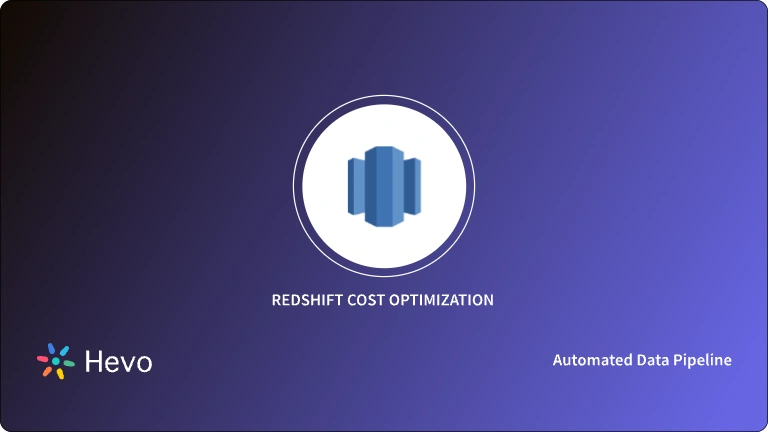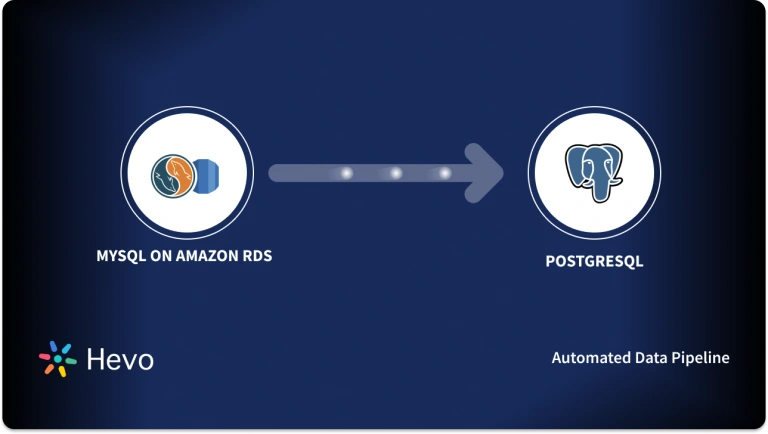Are you struggling to migrate your data from MySQL on Amazon RDS to Redshift? You’re not alone! Many businesses encounter difficulties in effectively analyzing and scaling data stored in Amazon RDS.
Fortunately, the migration to Amazon Redshift offers a promising solution to overcome these obstacles. In this article, we will explore two popular methods and step-by-step processes to integrate your data from MySQL on Amazon RDS to Redshift. Let’s dive in and simplify your MySQL on Amazon RDS to Redshift migration journey.
Method 1: Using AWS Data Pipeline
This method is time consuming and has various limitations like limited customization and performance impact. It involves a lot of steps to create an AWS Data Pipeline.
Method 2: Automating the Data Replication Process using a No-Code Tool
Using an automated, no-code tool like Hevo, you can start replicating your data in minutes. It only has two steps, i.e., configure source and destination. It is more convenient and effective.
Table of Contents
What Is MySQL On Amazon RDS?
Amazon RDS (Relational Database Service) allows users to deploy, manage, and scale MySQL databases in the cloud with ease. MySQL on Amazon RDS provides a fully managed MySQL environment where Amazon handles routine database tasks such as backups, patching, and scaling, freeing users from managing the underlying infrastructure.
Key Features
- Automated Management: Amazon RDS automates database setup, management, and maintenance, including automated backups, software patching, and monitoring.
- Scalability: MySQL on RDS offers easy vertical scaling of database resources without application downtime, allowing you to adjust performance based on workload requirements.
- High Availability: With Multi-AZ (Availability Zone) deployments, MySQL instances can be configured for automatic failover to ensure high availability.
- Security: MySQL on RDS supports encryption at rest and in transit, as well as integrating with AWS Identity and Access Management (IAM) for secure access control.
- Cost-Efficiency: You pay only for the resources you use, with options for on-demand or reserved instances, optimizing cost based on your usage patterns.
What Is Amazon Redshift?
Amazon Redshift is a fully managed, petabyte-scale data warehouse service offered by AWS. Designed for efficient querying and data analytics, it allows organizations to store and analyze large volumes of data quickly and cost-effectively. Redshift integrates seamlessly with various data sources and business intelligence tools, making it an excellent solution for big data processing.
Key Features
- Massively Parallel Processing (MPP): Redshift distributes workloads across multiple nodes, speeding up complex queries and enabling the analysis of massive datasets.
- Scalability: Users can scale Redshift clusters up or down by adjusting the number and type of nodes to handle larger datasets or higher query demand.
- Cost Efficiency: Redshift offers cost-saving options such as on-demand pricing, reserved instances, and data compression techniques that reduce storage costs.
- Data Integration: It easily integrates with AWS services (e.g., S3, DynamoDB), as well as third-party data sources and ETL tools for streamlined data pipelines.
- Security: Redshift includes encryption at rest and in transit, virtual private cloud (VPC) support, and integrates with AWS IAM for secure access.
How to Connect MySQL on Amazon RDS to Redshift?
Prerequisites
Before proceeding with the migration of MySQL on Amazon RDS to Redshift, keep these prerequisites in mind:
- An active AWS account
- Create a Redshift cluster
- Create a Redshift table
- Ensure AWS Data Pipeline is available in your region
- Create an S3 bucket in the same region as the Data Pipeline
Method 1: Using AWS Data Pipeline
Loading data from MySQL on Amazon RDS to Redshift using AWS Data Pipeline involves the following steps:
Step 1: Create an AWS Data Pipeline
- Log in to your AWS account and navigate to the Data Pipeline service.
- Click on Create Pipeline and enter the pipeline Name and Description.
Step 2: Choosing the Appropriate Template for Your Redshift Table
- Select the Source option to Build using a template. By selecting a template, you are specifying the data copying behavior for the integration process.
- From the drop-down menu, you can either select the Full Copy of Amazon RDS MySQL Table to Amazon Redshift template or Incremental Copy of an Amazon RDS MySQL Table to Amazon Redshift template.
- The Incremental template is suitable when you have an existing Redshift table and want to update it with only the changes from the RDS MySQL table.
Step 3: Provide the Amazon RDS Source Data
- Now, you must provide the necessary information about the source RDS instance, staging S3 location, and Redshift cluster instance.
Step 4: Select the Run Frequency
- You can either select to activate the pipeline immediately by choosing the Run on pipeline activation or Run on a Schedule for periodic execution. If you opt to schedule the pipeline, you can specify the desired frequency, date, and time for its activation.
- In the pipeline configuration section, By Enabling the Logging option and specifying the desired S3 location, you can copy execution logs to S3.
- For security and access settings, keep the IAM roles as default.
Step 5: Activate the Pipeline and Monitor its Status
- Click on the Activate button to initiate the pipeline.
- You can monitor the pipeline’s progress and status in the AWS pipeline console, where all pipelines are listed. Wait for the pipeline to complete its execution and reach the FINISHED status.
- Once the pipeline is established, you can view the newly created table in Redshift, indicating the successful completion of the integration process.
And there you have it! You have successfully loaded data from MySQL on Amazon RDS to the Redshift database. Here are the key benefits of using AWS Data Pipeline for MySQL on Amazon RDS to Redshift integration:
- Automate Data Workflows: With AWS Data Pipeline, you can automate complex data workflows, making it easier to manage and schedule data processing tasks. This automation minimizes the risk of human errors.
- Integration with AWS Services: Since AWS Data Pipeline is an AWS-native service, it seamlessly integrates with other AWS services like Amazon S3, AWS Glue, and AWS Lambda. This integration enhances the capabilities of your data workflows and enables you to build powerful data solutions.
Limitations Of Using AWS Data Pipeline
While the AWS Data Pipeline service offers advantages for migrating MySQL data from Amazon RDS to Amazon Redshift, it is essential to be aware of certain limitations:
- Performance Impact: During the MySQL on Amazon RDS to Redshift integration process, the source RDS database may experience a decrease in performance due to the additional resource consumption and processing requirements. To prevent this, it is advisable to make a separate copy of the database and perform the migration on the copy.
- Dependency on AWS Ecosystem: AWS Data Pipeline is tightly integrated with the AWS ecosystem, which might limit its usability for organizations using multiple cloud providers. Using AWS Data Pipeline could potentially lead to vendor lock-in, making it challenging to switch to another cloud provider without significant changes to the data migration process.
- Limited Customization: While AWS Data Pipeline provides pre-built templates for data migration, these templates may not fully meet your customization requirements. For complex migration needs, you might have to implement custom logic and transformations. It could involve writing custom scripts, using AWS SDKs, or third-party tools, leading to increased implementation time and potential maintenance challenges.
Method 2: Automating the Data Replication Process using a No-Code Tool
While migrating data from MySQL on Amazon RDS to Redshift, leveraging a no-code tool offers significant advantages:
- Scalability and Flexibility: No-code tools can handle large datasets and accommodate your changing business requirements. They often support batch processing and parallel execution, enabling efficient data migration. Additionally, the user-friendly interface allows you to easily modify migration workflows as needed, providing flexibility in adapting to evolving data migration needs.
- Real-Time Data Sync: By using a no-code tool, you can establish real-time synchronization between MySQL on Amazon RDS and Redshift. This ensures that Redshift has the most up-to-date data for analysis, enabling timely insights and decision-making.
- Data Consistency and Integrity: No-code tools often provide built-in validation checks and error-handling mechanisms, ensuring data consistency and integrity during migration. These tools can automatically handle data type conversions, schema mapping, and missing data, minimizing the risk of data inconsistencies.
To migrate data from MySQL on Amazon RDS to Redshift, follow these steps:
Step 1: Configure Amazon RDS MySQL as Source
Step 2: Configure Amazon Redshift as Destination
That’s it! You’ve effortlessly integrated your data from MySQL on Amazon RDS to Redshift.
What can you Achieve by Migrating Data from MySQL on Amazon RDS to Redshift?
Here’s what your data analyst can use to prepare analyses after MySQL on Amazon RDS to Redshift data replication.
- Aggregate the data of individual interaction of the product for any event.
- Finding the customer journey within the product (website/application).
- Integrating transactional data from different functional groups (Sales, marketing, product, Human Resources) and finding answers. For example:
- Which Development features were responsible for an App Outage in a given duration?
- Which product categories on your website were most profitable?
- How does Failure Rate in individual assembly units affect Inventory Turnover?
Here are some other migrations that you may need:
- MySQL on Amazon RDS to PostgreSQL
- MySQL on Amazon RDS to Redshift
- MySQL on Amazon RDS to Databricks
- MySQL on Amazon RDS to BigQuery
Conclusion
Migrating data from MySQL on Amazon RDS to Redshift offers numerous advantages, such as enhanced data analysis, scalability, and improved customer understanding. While AWS Data Pipeline provides a method for migrating data from Amazon RDS to Redshift, it may have limitations in terms of dependency on the AWS ecosystem and customization.
Learn how to integrate AWS RDS MSSQL with Redshift to enhance your data management. Our guide offers straightforward steps for effective data migration.
Alternatively, using a no-code tool like Hevo Data simplifies the MySQL on Amazon RDS to Redshift integration process. It offers extensive pre-built connectors from 150+ sources, and real-time data replication using Change Data Capture (CDC) technology, and provides user-friendly drag-and-drop transformations. Hevo Data stands out as an effective choice for a smooth and efficient MySQL on Amazon RDS to Redshift migration.
If you don’t want SaaS tools with unclear pricing that burn a hole in your pocket, opt for a tool that offers a simple, transparent pricing model. Hevo has 3 usage-based pricing plans starting with a free tier, where you can ingest up to 1 million records.
Schedule a demo to see if Hevo would be a good fit for you, today!
FAQs
1. How to transfer data from RDS to Redshift?
To transfer data from RDS to Redshift, you can use AWS Data Migration Service (DMS) or manually export data from RDS to S3 in a format like CSV or Parquet, then load it into Redshift using the COPY command. DMS automates the process, supporting ongoing replication for real-time data transfer.
2. How to migrate MySQL to Redshift?
To migrate MySQL to Redshift, you can use AWS Data Migration Service (DMS) for a seamless transfer. Alternatively, export MySQL data to Amazon S3 in CSV or Parquet format and use Redshift’s COPY command to load the data. DMS supports continuous replication for near real-time migrations.
3. Can MySQL connect to Redshift?
MySQL cannot directly connect to Redshift, as they are separate databases. However, you can transfer data between them using AWS Data Migration Service (DMS) or by exporting MySQL data to S3 and then loading it into Redshift using the COPY command.
4. How do I stream MySQL to Redshift?
To stream data from MySQL to Redshift, you can use AWS Data Migration Service (DMS) for continuous data replication. DMS captures changes in MySQL (CDC) and streams them to Redshift in near real-time, allowing seamless and automated data transfer between the two databases.










